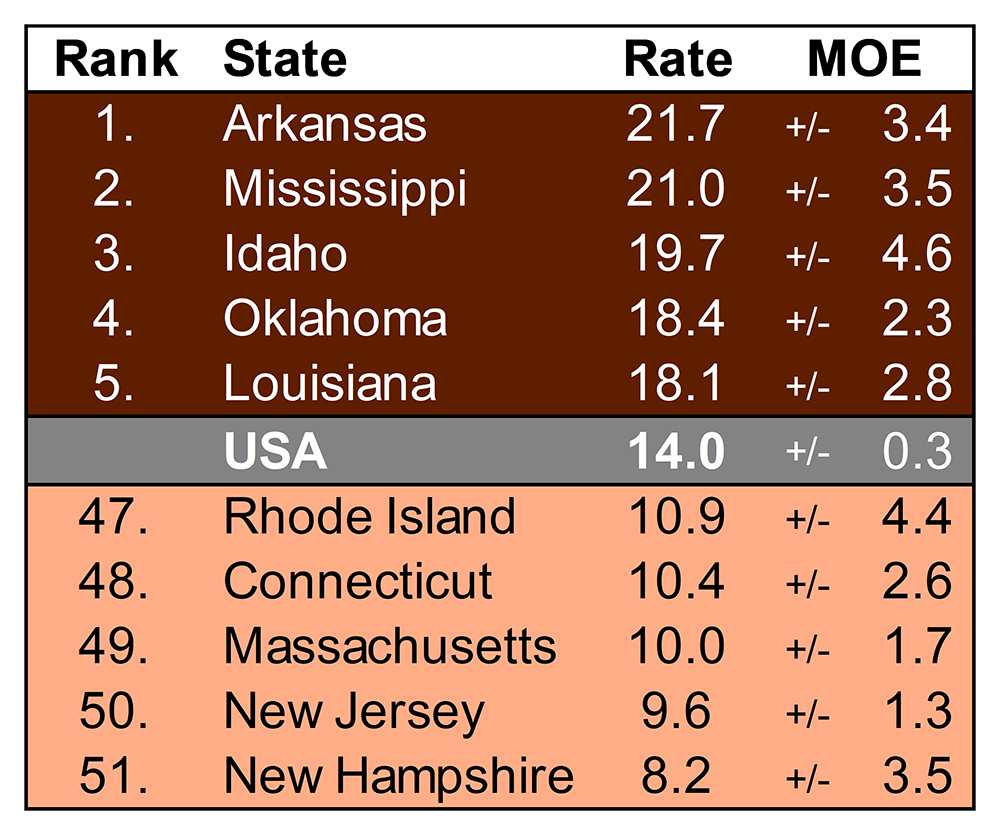Divorce Rate in the U.S.: Geographic Variation, 2021
Family Profile No. 26, 2022
Author: Francesca A. Marino
Figure 1. Map of State-level Adjusted Divorce Rates in the U.S., 2021
The adjusted divorce rate in the U.S. peaked in 1979 (see Figure 1). The general trend since then has been one of decline, and analyses of divorce trends using the American Community Survey beginning in 2008 indicate successive yearly declines beginning in 2012 (Westrick-Payne, 2022a). The pandemic has had dramatic effects on divorce in the U.S. with a 12% reduction in administrative counts of divorces, which are available from 35 states (Westrick-Payne, Manning, & Carlson, 2022). The ACS shows a parallel trend with a nearly 10% decline in the adjusted divorce rate from 15.5 in 2019 to 14.0 in 2020 (Westrick-Payne, 2022b). Using the 2021 1-year estimate of the American Community Survey (ACS), we estimated the number of divorces and divorce rates among women ages 15 and older in the United States and show how these rates vary across states. This Family Profile is an update of previous profiles that examine the divorce rate across each state [FP-17-24; FP-18-21; FP-19-23; FP-20-25; FP-22-08].
U.S. Adjusted Divorce Rate, 2021
- The number of women who reported they divorced declined from 960,014 in 2020 (Westrick-Payne, 2022b) to 948,862 in 2021.
- The divorce rate, however, remained unchanged at 14.0 divorces per 1,000 married women in both 2020 and 2021.This rate is the lowest level over a 40-year time span.
Figure 2. Women’s Adjusted Divorce Rate, 1970-2021
Five Highest and Lowest Adjusted Divorce Rates, 2021
- Arkansas had the highest divorce rate among women in the U.S., with 21.7 women divorcing in the last year per 1,000 married women.
- The state with the lowest divorce rate in 2021 was New Hampshire, with 8.2 divorces per 1,000 married women.
Figure 3. Women's Highest and Lowest Adjusted Divorce Rates, 2021

State Rankings and Geographic Variation in Divorce Rates, 2021
- The 13 states in the top quartile had rates of at least 16.0 divorces per 1,000 married women in 2021.
- The 13 states in the bottom quartile had 12.5 or fewer divorces per 1,000 married women in 2021.
- Most states in the South and West had divorce rates in the top two quartiles.
- Exceptions included Virginia, New Mexico, Arizona, South Dakota, and California.
- Most states in the Midwest and Northeast had lower divorce rates and can be found predominately in the third and fourth quartiles.
- Exceptions included Indiana, Kentucky, West Virginia, Vermont, and Maine.
Figure 4. State-Level Women’s Adjusted Divorce Rate by Quartile, 2021

Data Sources:
Clarke. S. C. (1995). Advanced report of final marriage statistics, 1989 and 1990. Monthly Vital Statistics Report, 42(12). National Center for Health Statistics. https://www.cdc.gov/nchs/data/mvsr/mv43_12.pdf
National Center for Health Statistics (1974). Summary report final marriage statistics, 1970. Monthly Vital Statistics Report, 23(2), Supp.1. U.S. Department of Health, Education, and Welfare. https://www.cdc.gov/nchs/data/mvsr/supp/mv23_02s1acc.pdf
National Center for Health Statistics (1983). Advance report of final marriage statistics, 1980. Monthly Vital Statistics Report, 32(5), Supp. U.S. Department of Health and Human Services. https://www.cdc.gov/nchs/data/mvsr/supp/mv32_05s.pdf
National Center for Health Statistics (2001). Births, marriages, divorces, and deaths: Provisional data for January-December 2000. National Vital Statistics Report, 49(6), Associated Table 3. Department of Health & Human Services, Center for Disease Control and Prevention. https://www.cdc.gov/nchs/data/nvsr/nvsr49/nvsr49_06.pdf
U.S. Census Bureau (2022). American Community Survey, 2021 1-Year Estimates [Table B12001]. Retrieved from: https://data.census.gov/cedsci/table?q=B12001&tid=ACSDT1Y2021.B12001
U.S. Census Bureau (2022). American Community Survey, 2021 1-Year Estimates [Table B12501]. Retrieved from: https://data.census.gov/cedsci/table?q=B12501&tid=ACSDT1Y2021.B12501
U.S. Census Bureau (2021). American Community Survey, 2020 1-year Experimental PUMS
References:
Allred, C. (2019). Divorce rate in the U.S.: Geographic variation, 2018. Family Profiles, FP-19-23. Bowling Green, OH: National Center for Family & Marriage Research. https://doi.org/10.25035/ncfmr/fp-18-23
Hemez, P. (2017). Divorce rate in the U.S.: Geographic variation, 2016. Family Profiles, FP-17-24. Bowling Green, OH: National Center for Family & Marriage Research. https://doi.org/10.25035/ncfmr/fp-17-24
Reynolds, L. (2020). Divorce rate in the U.S.: Geographic variation, 2019. Family Profiles, FP-20-25. Bowling Green, OH: National Center for Family & Marriage Research. https://doi.org/10.25035/ncfmr/fp-20-25
Schweizer, V. (2018). Divorce rate in the U.S.: Geographic variation, 2017. Family Profiles, FP-18-21. Bowling Green, OH: National Center for Family & Marriage Research. https://doi.org/10.25035/ncfmr/fp-18-21
Westrick-Payne, K. K. (2022). Divorce rate in the U.S.: Geographic variation, 2020. Family Profiles, FP-22-08. Bowling Green, OH: National Center for Family & Marriage Research. https://doi.org/10.25035/ncfmr/fp-22-08
Westrick-Payne, K. K., Manning, W. D., & Carlson, L. (2022). Pandemic Shortfall in Marriages and Divorces in the United States. Socius, 8. https://doi.org/10.1177/23780231221090192
Suggested Citation:
Marino, F. (2022). Divorce rate in the U.S.: Geographic variation, 2021. Family Profiles, FP-22-26. Bowling Green, OH: National Center for Family & Marriage Research. https://doi.org/10.25035/ncfmr/fp-22-26
Updated: 11/10/2025 04:27PM

